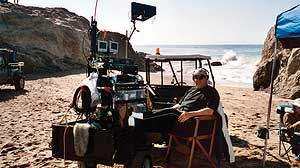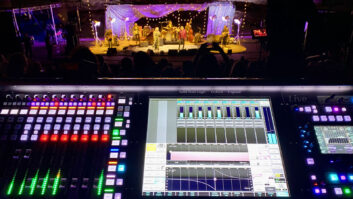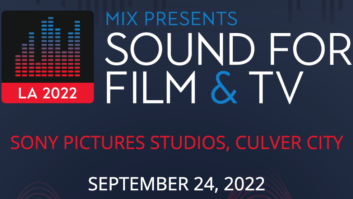
John Coffey in the field with a beach cart.

Robert Kennedy and friend on location in Malibu.
Motion picture production is up, it’s down. Reality TV is big, it’s slowing. How is business?
John Coffey: We got hit like everybody else in ’08/’09, but seem to be coming out of it okay. There is labor peace and contracts have been signed. For a while there, it was a novelty to watch YouTube viral videos when it was seen as the entertainment of the future. It is not. A good product takes money and the time to make it. I think we’re coming out of this fine and we’re looking at the best film year in our history. The industry in general has done well. I’m a big believer in following worst-case scenarios, and the Great Depression represented a golden age of filmmaking.
Have you seen any trends emerging in either technology or staffing?
Coffey: The new trend, and it’s not all that new, is to put a wire on every actor, especially in reality TV, so that anybody might speak and at any time. Take a show like Extreme Makeover Home Edition: They have three guys out with eight radios each and all the equipment that requires over the shoulder. Right now, reality audio guys have the hardest job in the world. They’re almost like pack mules. It used to be that you never carried more than four wireless transmitters with you, and you felt like you failed if you used all four that day.
We’re lucky in production in that once there was a move to two-man crews. But now there is more work than ever on the set and a third man is not only necessary, but often a fourth man is needed to wrangle all the wires and run everything down. While audio equipment has gotten smaller and cheaper, fortunately the sound crews are not really shrinking.
Robert Kennedy: I liken it to moving around like a pregnant woman. The technology has advanced to a level where you can carry a 10-track, or even a 16-track, recorder over your shoulder and all the wires. Unfortunately, all those extra mic sources and the time needed to keep them at 100 percent leaves less time for mixing.
What about technology?
Kennedy: The centerpiece of any production cart or bag is the mixer and the recorder, and the recent evolution is the merging of those two pieces so you no longer need the audio connection from mixer to recorder—half the number of connections and half the number of fail points. And now both Sound Devices and Zaxcom have come out with flat-panel control devices that are really light weight and consume very little power.
Another thing that’s interesting is the evolution of digital wireless to where they are remote-controllable. Sony, Lectrosonics and Zaxcom have digital or digital hybrid wireless that gives a sound mixer a higher level of control over the transmitter, which is where the trim for the microphone is. The ability to interact with the transmitter remotely allows for other interesting things like recordings on the unit that are timecode-stamped. That’s your multitrack backup in the field—ideal for things like parachutists, or car shots beyond the range of RF, or when the RF evironment is really caustic. When reception is difficult, you have a recording right on the actor, so when they finish a scene you have a playback from the recording and you can download from the memory card on the transmitter or just turn in the card itself as the media—remarkable technology.
With production taking place all over the world and the loss of the “apprentice” system, do you find yourselves becoming educators?
Coffey: More than ever. This is our 24th year now, and we take a lot of pride in adding value to our customers, whether it’s a student or a 30-year veteran. There’s a new era of technology that’s ushered in almost yearly now. Any time there is a major change, like with the move toward digital recording with Deva, we’ve felt that it’s important to be the ones to lead the way, and we have the arrows in our back to prove it! [Laughs] DAT machines are obsolete now, but it wasn’t long ago that they were the coolest thing. Now it’s hard disk and file-based and workflows, and we see Flash recording coming in a big way.
We also put out a quarterly magazine, the Coffey Files, and we host what we call a monthly Coffey Klatch the first week of every month. These are often SRO, and we take the videos and post them online each month. We also host forums on our site, so our educational sessions are growing and growing, especially as they involve equipment and the workflow to go along with it. Coffey Sound is now part of a group of post houses, including Laser Pacific here in L.A. A lot of our efforts recently have involved workflow and transferring files between production and post.
The industry has changed so much technically that we have to hire people now just to stay educated so they can teach our customers what it all means. We want to be the ones you call when you’re in the middle of a field in Iowa, with one bar left on your cell phone battery and the director is giving you the evil eye because something went wrong. We thrive on turning negatives into positives.







